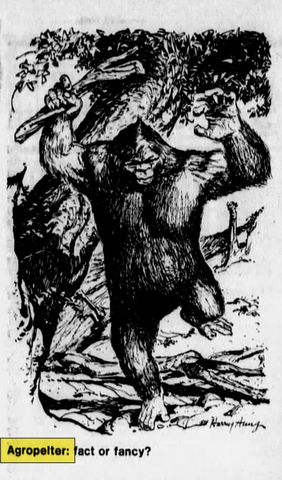![Agropelter - [Fearsome Critter]](http://samkalensky.com/cdn/shop/files/80ABA4F7-F0E7-46A3-80D7-28630B2A8AC3_{width}x.jpg?v=1697307262)
Agropelter. - [fearsome critter] - Latin: (Anthrocephalus craniofractens.)

• About this Critter: Also known as the 'widow-maker' or the 'fool killer' This nasty creature is known to inhabit hollow, dead trees in the wild woods from Main to Oregon (where attacks were most commonly reported during the early days of the North American timber Industry.) - Often described as a villainous, ape-like creature, with slender, whip-like arms. - it bears an eternal grudge and extreme malice against intruding loggers, it was often blamed for the dissappearance of many in the forestry service... Lumberman have been pelted by falling twigs and pinecones tossed by the beast, resulting in injury. The beast especially delights in whacking unsuspecting Lumbermen out cold up over the head with a sturdy branch. The Injured lumbermen are usually found brutally smashed to pieces or pinned under a hefty dead branch, the victim is often reported as having been 'accidentally killed by a falling limb' but old folks knew well that the Agropelters were to blame...

The Agropelter is included in most literature on the subject of fearsome critters and is yet another with a near-perfect attendance record appearing in Cox's [1910] CEbrowns [1935] Tryon's [1939] Myers [1958] Wymans [1969] and most others' bestiary works on the subject of fearsome critters. (is it really a lumberwoods bestiary without an Agropelter?) - Cox's book even gets recounted by Marjorie Edgar in the Minnesota history books. [1940] - The Critters appearance has been mostly the same (ape-like with whip-arms) since Cox's description (below.) - Agropelters where most often described as appearing "ape-like" though chimp & man-like variants have also been described by Tyron and others. Many also say that the creature is so quick in and out of a log that it hasn't been seen and theres no proper description for it. - According to some, the Agropelters of Minnesota's fur is regularly infested by Snow Fleas, certain witnesses have also described the creature as having sharp teeth as fine as needles (the kind used to repair socks), that they have furry faces that resembleing skulls or that they have a thin body like that of a starved bear. The creature often is said to be Endangered because of its odd diet (woodpeckers and hoot owls) and its odd breeding habits, Agropelters are said to only bear young 'pups' on leap years. (Specifically February 29th.) Litters are usually said to come in odd numbers. - However, these descriptions are very far and few between. [Newspapers from the 40s & onwards often said that the agropelter was already becoming extinct]
At its roots i feel the creature is best described by Minnesota State forester, William T Cox's [1910] 'Fearsome Creatures of the Lumberwoods' included description goes as follows:
THE AGROPELTER. (Anthrocephalus craniofractens.)
" Leading a vengeful existence, resenting the intrusion of the logger, the agropelter deals misery to the lumber jack from Maine to Oregon. Ill fares the man who attempts to pass a hollow tree in which one of these creatures has taken up its temporary abode. The unfortunate is usually found smashed or pinned by a dead branch and reported as having been killed by a falling limb. So unerring is the aim of the argropelter that despite diligent search I have been unable to locate more than one man who has been the target for one of their missiles and yet survived to describe the beast. This is Big Ole Kittleson, who, upon a certain occasion, when cruising timber on the upper St. Croix, was knocked down by a partly rotten limb thrown by an argropelter. This limb was so punky that it shattered on Ole's head, and he had time to observe the rascally beast before it bounded from the tree and whisked itself off through the woods.
According to Ole, the animal has a slender, wiry body, the villainous face of an ape, and arms like muscular whiplashes, with which it can snap off dead branches and hurl them through the air like shells from a six-inch gun. It is supposed to feed upon hoot owls and woodpeckers, the scarcity of which will always prevent the argropelter from becoming numerous in any locality"
[as seen in fearsome critters 1939]
[Note: "Big Ole Kittleson" might have been actually been "Ole Kettleson" (seemingly an actual person and a somewhat famous Ranger Supervisor who was said to be handy with a gun, He's often spoken of in a few Victoria Forest service Newletters from 1922-1960s [According to my research the man travelled between Vancouver area & the states quite a bit.] unfortunately, its impossibble to verify if hes actually the same person or not. as 'Big Ole' also seems to have been a popular nickname shared between several workers: Notably, 'Big Ole' was also the name given to Paul Bunyans Blacksmith at the 'Big Onion camp.' - The Agropelter also makes appearances widely in Paul Bunyan Novels & lore.]

• See also: Sasquatch, SwingDingle, Whirling wimpus, Haggletopelter.

Art sticker by samkalensky part of my fearsome critters collection of stickers, if you like these bios please consider supporting my Patreon for more.

![Agropelter - [Fearsome Critter]](http://samkalensky.com/cdn/shop/files/83EA32A0-B9CE-4FBD-96AE-5803286E3A11_{width}x.jpg?v=1697307262)
![Agropelter - [Fearsome Critter]](http://samkalensky.com/cdn/shop/files/074009F0-9066-4BBF-981A-FDA4757E7552_{width}x.jpg?v=1697307262)
![Agropelter - [Fearsome Critter]](http://samkalensky.com/cdn/shop/files/93F84207-B14D-4B43-9A83-B0DB19F252A0_{width}x.jpg?v=1697307262)
![Agropelter - [Fearsome Critter]](http://samkalensky.com/cdn/shop/files/A307D986-8B6C-49D4-95B4-F76698DC7F9E_{width}x.jpg?v=1697307262)
![Agropelter - [Fearsome Critter]](http://samkalensky.com/cdn/shop/files/0E1DF323-D295-4DA1-91B4-D5E22A01B862_{width}x.jpg?v=1697307253)
![Agropelter - [Fearsome Critter]](http://samkalensky.com/cdn/shop/files/BECBFF10-B31E-404E-AAAE-355121B393F6_{width}x.jpg?v=1697307256)
![Agropelter - [Fearsome Critter]](http://samkalensky.com/cdn/shop/files/9D71D303-D809-4FEA-BFE7-319EC77FE4DC_{width}x.jpg?v=1697307256)
![Agropelter - [Fearsome Critter]](http://samkalensky.com/cdn/shop/files/719654B7-3DF6-41FA-8948-2E76434EFDC9_{width}x.jpg?v=1697307253)
![Agropelter - [Fearsome Critter]](http://samkalensky.com/cdn/shop/files/C19155EB-C069-46ED-AEA5-AAC763FEA964_{width}x.jpg?v=1697307254)
![Load image into Gallery viewer, Agropelter - [Fearsome Critter]](http://samkalensky.com/cdn/shop/files/80ABA4F7-F0E7-46A3-80D7-28630B2A8AC3_110x110@2x.jpg?v=1697307262)
![Load image into Gallery viewer, Agropelter - [Fearsome Critter]](http://samkalensky.com/cdn/shop/files/83EA32A0-B9CE-4FBD-96AE-5803286E3A11_110x110@2x.jpg?v=1697307262)
![Load image into Gallery viewer, Agropelter - [Fearsome Critter]](http://samkalensky.com/cdn/shop/files/074009F0-9066-4BBF-981A-FDA4757E7552_110x110@2x.jpg?v=1697307262)
![Load image into Gallery viewer, Agropelter - [Fearsome Critter]](http://samkalensky.com/cdn/shop/files/93F84207-B14D-4B43-9A83-B0DB19F252A0_110x110@2x.jpg?v=1697307262)
![Load image into Gallery viewer, Agropelter - [Fearsome Critter]](http://samkalensky.com/cdn/shop/files/A307D986-8B6C-49D4-95B4-F76698DC7F9E_110x110@2x.jpg?v=1697307262)
![Load image into Gallery viewer, Agropelter - [Fearsome Critter]](http://samkalensky.com/cdn/shop/files/0E1DF323-D295-4DA1-91B4-D5E22A01B862_110x110@2x.jpg?v=1697307253)
![Load image into Gallery viewer, Agropelter - [Fearsome Critter]](http://samkalensky.com/cdn/shop/files/BECBFF10-B31E-404E-AAAE-355121B393F6_110x110@2x.jpg?v=1697307256)
![Load image into Gallery viewer, Agropelter - [Fearsome Critter]](http://samkalensky.com/cdn/shop/files/9D71D303-D809-4FEA-BFE7-319EC77FE4DC_110x110@2x.jpg?v=1697307256)
![Load image into Gallery viewer, Agropelter - [Fearsome Critter]](http://samkalensky.com/cdn/shop/files/719654B7-3DF6-41FA-8948-2E76434EFDC9_110x110@2x.jpg?v=1697307253)
![Load image into Gallery viewer, Agropelter - [Fearsome Critter]](http://samkalensky.com/cdn/shop/files/C19155EB-C069-46ED-AEA5-AAC763FEA964_110x110@2x.jpg?v=1697307254)

